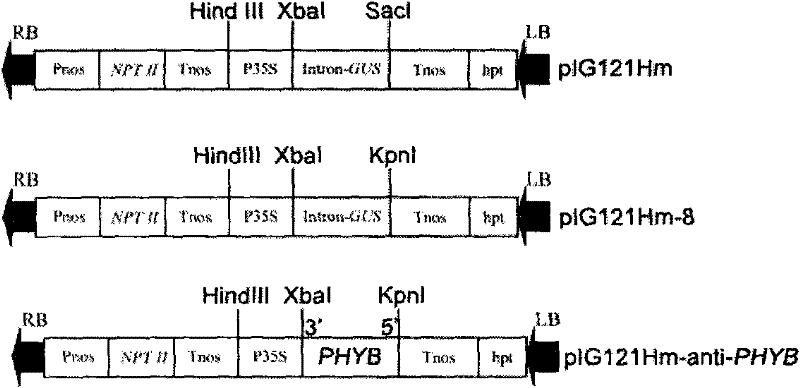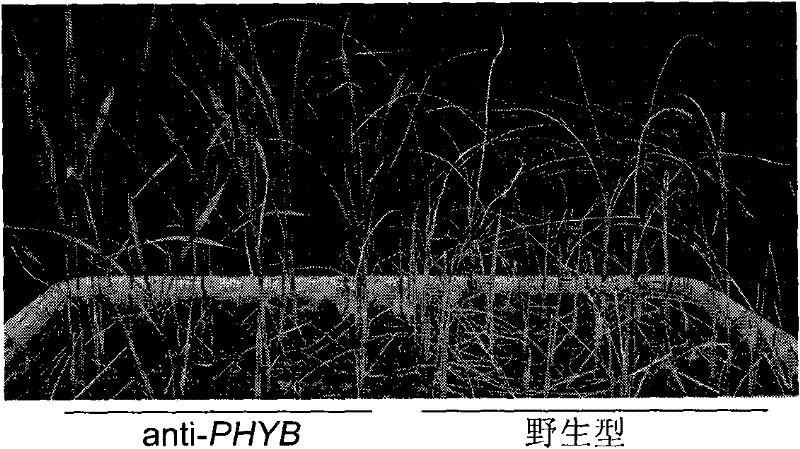Application of gene PHYB for controlling rice drought stress toleration
A drought stress, rice technology, applied in the direction of genetic engineering, plant genetic improvement, application, etc., can solve the problems of blindness of drought-resistant molecular breeding, and achieve the effect of improving drought stress tolerance
- Summary
- Abstract
- Description
- Claims
- Application Information
AI Technical Summary
Problems solved by technology
Method used
Image
Examples
Embodiment 1
[0022] Example 1: Isolation and cloning of DNA fragments used to construct antisense PHYB gene plant expression vectors
[0023] Total RNA was extracted from leaves of rice variety Nipponbare (a publicly reported variety) using TRIZOL reagent (Invitrogen). The specific steps are as follows: put 20 mg leaves into a liquid nitrogen pre-cooled mortar, add liquid nitrogen and quickly grind them into powder, put the powder into a 1.5ml centrifuge tube, quickly add 1ml Trizol (Invitrogen) and invert to mix well, and leave at room temperature Let stand for 5 minutes. Centrifuge at 12,000 rpm for 10 minutes at 4°C, and transfer the supernatant to a new 1.5ml centrifuge tube. Add 200 μl of chloroform, shake vigorously by hand for 15 seconds, and let stand at room temperature for 2-3 minutes. Centrifuge at 12000 rpm for 15 minutes at 4°C. Take the colorless aqueous phase into a new 1.5ml centrifuge tube, add 250μl isopropanol, 250μl high salt solution, invert and mix well, and let st...
Embodiment 2
[0025] Embodiment 2: Construction and genetic transformation of antisense PHYB gene plant expression vector
[0026] In order to better analyze the function of PHYB, the applicant reduced the expression level of PHYB gene in rice through antisense technology. The function of the gene was studied according to the phenotype and physiological characteristics of the transgenic plants.
[0027] The construction method of the antisense PHYB gene plant expression vector is as follows: first, the positive clone pMD18-PHYB cDNA obtained in Example 1 was double-digested with KpnI and XbaI, and the insert was recovered; Plant expression vectors, recovery of vector fragments. Use the recovered insert and vector fragments for ligation to transform Escherichia coli XL1-Blue. Positive clones were screened by enzyme digestion to obtain a plant expression vector named pIG121Hm-anti-PHYB (see figure 1 ). pIG121Hm-8 is obtained by replacing the SacI site between the coding region and the ter...
Embodiment 3
[0118] Example 3: Detection of PHYB protein levels in transgenic rice plants and wild-type rice
[0119]The rice variety Nipponbare and 5 independent T3 transgenic rice plants were used as materials to extract the soluble protein of rice leaves at the 5-leaf stage, and the level of PHYB protein in rice leaves was detected by western blot. The specific method is as follows; 1 g of rice leaves were collected from the above materials, thoroughly ground in liquid nitrogen, and 2 ml of protein extraction buffer (100 mM Tris-HCl, pH 8.3, 5 mM EDTA, 0.2% β-mercaptoethanol and protease inhibitor mixture) was added , mix well, and place on ice for 30 minutes. Then centrifuge at 12000×g for 15 minutes at 4°C. Transfer the supernatant to another tube, add 2 / 3 volume of saturated ammonium sulfate, mix well, and let stand on ice for 30 minutes. Centrifuge at 12000×g for 30 minutes at 4°C. Discard the supernatant and suspend the pellet with 200 μl protein extraction buffer. Protein conc...
PUM
 Login to View More
Login to View More Abstract
Description
Claims
Application Information
 Login to View More
Login to View More - R&D
- Intellectual Property
- Life Sciences
- Materials
- Tech Scout
- Unparalleled Data Quality
- Higher Quality Content
- 60% Fewer Hallucinations
Browse by: Latest US Patents, China's latest patents, Technical Efficacy Thesaurus, Application Domain, Technology Topic, Popular Technical Reports.
© 2025 PatSnap. All rights reserved.Legal|Privacy policy|Modern Slavery Act Transparency Statement|Sitemap|About US| Contact US: help@patsnap.com



